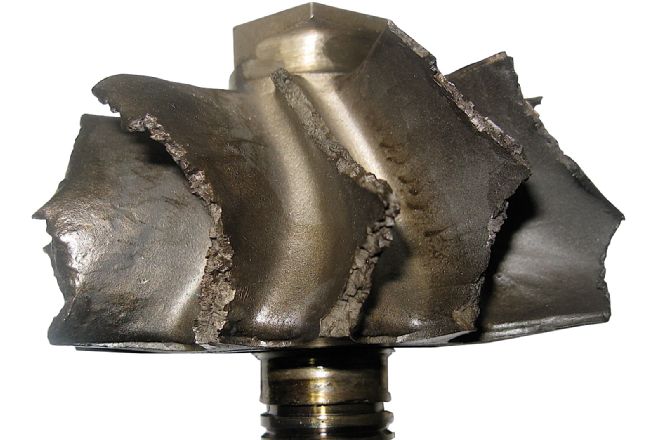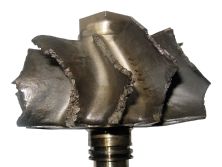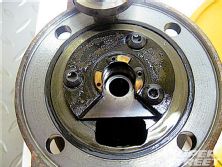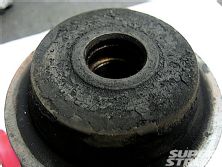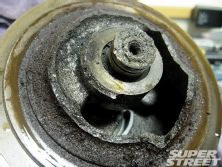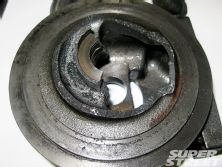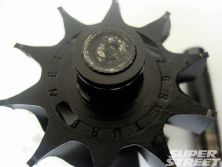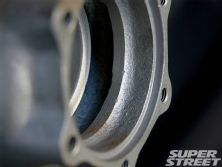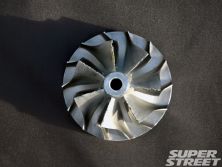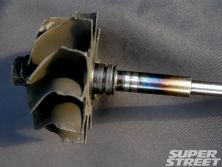We think of turbochargers as god-like challengers of physics, capable of miraculously expanding the size on an engine and endowing it with awe-inspiring amounts of power. But as divine and brutish as turbos come off, the truth is a rather precarious wafer-thin layer of oil is all that's keeping a fiercely boosting turbo from going critical mass, sending shrapnel flying and bringing the party to a halt.
The point of contention is the center section; the main shaft and a collection of bearings that keep the wheels purring even at stratospheric 100,000-rpm speeds. Generally turbo-bearing failure can play out in two ways-a quick death by oil starvation or a long, drawn out suffering compliments of an imbalance. Of course, there are more ways a turbo can meet its maker but these are the most prominent.
Oil starvation can be the result of simply burning oil, kinking a turbo oil line, losing oil pressure in some manner, suffering from oil coking or any number of other horror show scenarios. When this happens in a sudden and significant manner the bearing squeals and seizes or the wheel violently slams into the housing, which in many cases can twist the wheel completely off the shaft. Bottom line, it's game over for your turbo.
The end came quickly for these poor turbos. Death by wheel shaft snap and a twin killing featuring death by wheel explosion/housing burst. The culprit is profound neglect as evidenced by the coked oil residue resulting in a single, catastrophic event. Either way something serious has gone down. But it's not always quick. A gradual oil starvation can compromise the turbo's bearing and lead to a wheel imbalance. The wheel assembly can see well over 120,000 rpm, which explains why balance is so critical.
In this 'slow-motion' scenario the bearing wears over time and the wheel develops an oscillation, or "wobble". From here it's not a question of if but when critical mass is reached. The wobble progresses until wheel-to-housing contact brings down the curtain. Initially, the wheel contacts or scrapes the inner wall housing and the resulting friction robs spool-up speed and full-boost power production. Further, the contact breaks off pieces of the wheel blades, which enhances the imbalance and speeds the turbo toward its ultimate demise by increasing the severity of the imbalance. Beyond the torture within the turbo, in the case of compressor wheels, these blade remnants can be blown through the system and wreak havoc on the intercooler and internal engine parts in the valvetrain and inside the engine.
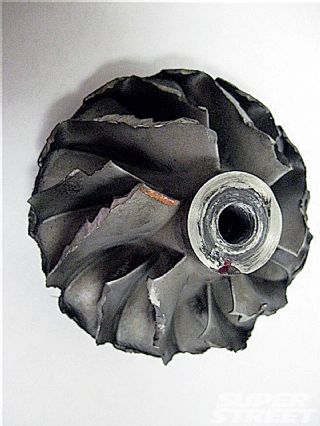 |
Turbo Failure: Boost Up Instead Of Blowing Up
|
Turbo Failure: Boost Up Instead Of Blowing Up
To evaluate a suspect turbo remove the intake set-up before the compressor inlet so you can access the wheel. Spin the wheel by the nut and note any resistance or rubbing; keep your ears open because you should be able to hear a scraping sound. Also check the shaft for endplay and lateral movement at the shaft nut; wiggle it. Bearing clearances can be properly and accurately checked with a dial indicator. The key numbers here are more than .003 to .006 inches (up and down) while endplay should be no more than .001 to .003 inches (in and out).
Compressor wheels can also be damaged by outside forces, read foreign object damage (FOD). Poor filtration (or no filtration) can introduce dust and dirt into the compressor. The objects can sandblast, chip, bend or break off blades causing an imbalance and assuring the turbo's eventual failure.
Charbroiled oil can also bring down the hammer on an unsuspecting center cartridge. Coking is burnt oil residue, a hardened version of the sludge we see falling from the sky in those Castrol GTX commercials. The coked oil blocks the flow of oil through the bearing, which signs the turbo's death certificate.
The residue at the base of this turbine wheel is oil coking. The coked oil residue conducts heat via friction, which takes out the turbo. The bluing on the shaft is a testament to how intense the heat can get prior to failure. It has also suffered foreign object damage and has shaft grooving from bearing failure. What did this turbo do wrong to deserve such abuse?
Using the proper oil; weight/viscosity wise as well as type wise, and change it at proper intervals will combat this evil. First and foremost step up to a quality synthetic; the anti-friction qualities of synthetics are light years beyond conventional, mineral-based offerings. Next, play the numbers game right. Basically the greater the difference between the numbers of multi-viscosity oil the worse the product will be for a turbo application. Stick with factory recommended weights, squeezing 1.3 extra horsepower from your engine with some 0-weight madness is not worth the long-term peril improper lubrication represents.
Let's breakdown oil viscosity ratings with 10W-40. The '10' is the oil's viscosity rating at 0 degrees. The 'W' signifies winter. The '40' rating is the oil's viscosity rating at 212 degrees. Oil engineers must balance these ratings and match the engine's operating parameters and weather conditions the engine will see.
Employing an oil cooler can help eliminate the heat that causes coking and reap benefits for the engine's internals. Also turbo timers allow the turbo to cool properly as coking can be the result of hot shutdown where the wheel assembly spins with no movement of its lubrication, which breaks down the bearing's protective film of oil causing metal-to-metal contact. These maladies, along with poor maintenance habits, poor oil quality and starvation issues and can tag team to produce oil coking or other catastrophic conditions that spell doom to your turbo.
Diligence is key to long turbo life. Using the right oil, changing it often and knowing where the pitfalls live will keep your turbo purring and your adrenal gland pumping for miles to come.

